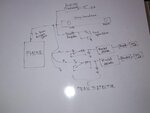c_mitra
Advanced Member level 6
Because you will not be able to see the high frequency modulation of the LEDs, you need to first filter out all med and high frequency and keep only the low frequency components for the LED modulation. Use a low pass filter that cuts off all frequencies above 100Hz. Drive the LEDs via a transistor (or a MOSFET) and bias the base so that the LEDs just light up without any signal. Next connect your audio signal and have fun. You may also need an AGC stage before the transistor driver.
